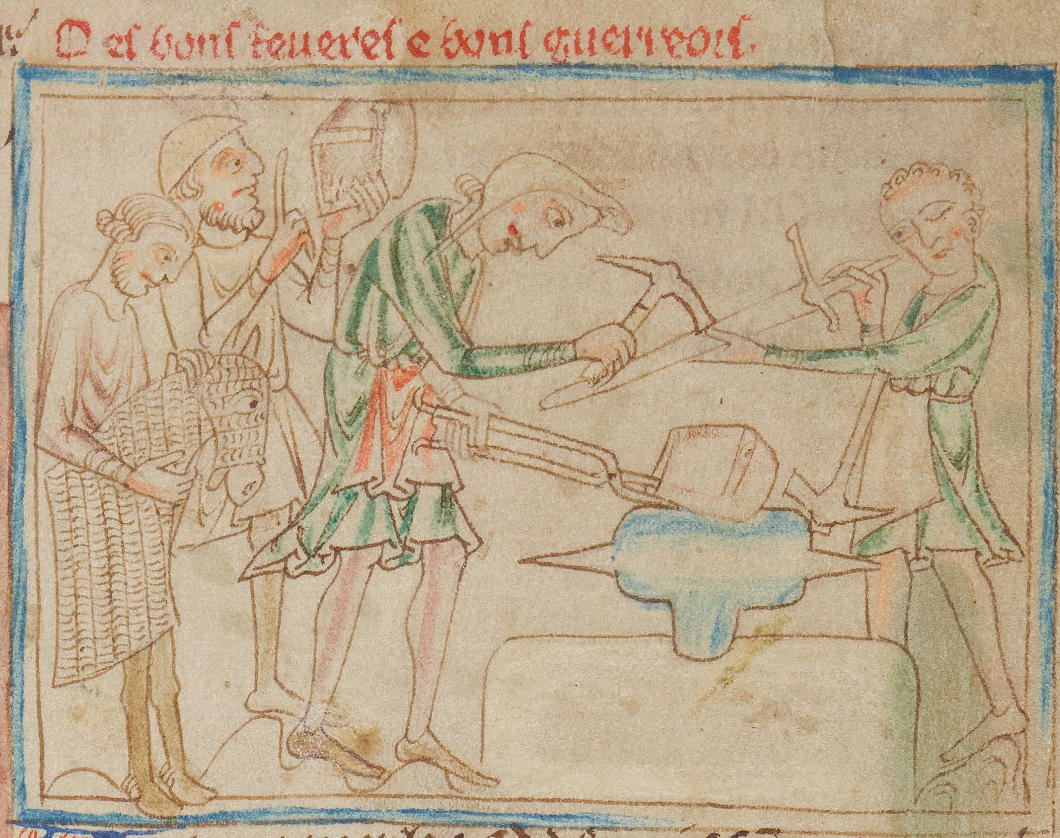Try Amazon Audible Premium Plus and Get Up to Two Free Audiobooks

Create an Amazon Business Account
Illustration of military interest from
Romance of Alexander by Thomas of Kent
Deſ bonſ feuereſ e bonſ guerreorſ.
Of good blacksmiths and good warriors.

A larger image of f.24r, Romance of Alexander by Thomas of Kent.
Illustration 51. Folio 24r right-top.
One covers a horse with mail, one examines a helmet, another a sword, the fourth forges a helmet on an anvil.
Title: Thomas of Kent, Romance of Alexander
Shelfmark: O.9.34
James Number: 1446
Date: 13th century (1250).
Physical Description: Double columns of 46 lines. In a good clear hand (English), with a large number of excellent drawings.
Provenance: Marked H 12. No. 326.
The volume is illustrated by 152 pictures in fine outline, lightly washed with colours, green, red, and blue - green being perhaps the most conspicuous.
The work is excellent: and the style of both drawing, colouring and writing inclines me to hazard the conjecture that the birthplace of the volume was St Albanís Abbey.
The frames of the drawings are edged (alternately, roughly speaking) with green and pink.
Religious House: St Albans, Hertfordshire, Benedictine Abbey
Size (cms): 29 x 20.5
Support: Vellum.
Language: Old French
Folios: 46 ff.
Attribution: Trinity College, Cambridge
Referenced on p.177, Arms and Armour of the Crusading Era, 1050-1350, Western Europe and the Crusader States by David Nicolle.
195A-I Roman de Toute Chevalerie, England, mid-13th century
(Trinity College Library, Ms. O.9.34, Cambridge, England)
The horsemen in one miniature (H and I) are equipped with standard mid-13th-century arms.
The horse-armour does, however, demand comment.
It is of mail and is clearly made in two separate pieces, one for the head, neck and foreparts of the animal, and one to protect the rump.
It seems most unlikely that a man would go into battle with only half a horse-armour (I).
On the other hand representations of horses wearing only the rear part of a caparison, though not necessarily an armoured bard, were seen in Spain.
Elsewhere an armourer is shown carrying the front part of a mail bard or horse-armour (A).
Others test the symmetry of a pointed great helm (B), make a flat-topped great helm (C), and probably inspect the positioning of quillons on a sword (D).
Another man puts on a mail hauberk that includes coif and mittens (E), presumably to be followed by the great helm at his feet.
Elsewhere a horsemanís sword (F) breaks against the mailed shoulder of his foe (G).
The latter figure rides a horse with a full mail bard.

Back to illustrations from the 'Romance of Alexander' by Thomas of Kent. Trinity College, Cambridge, England. MS O.9.34.



